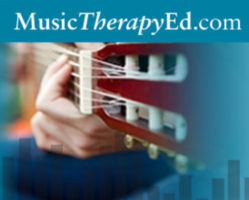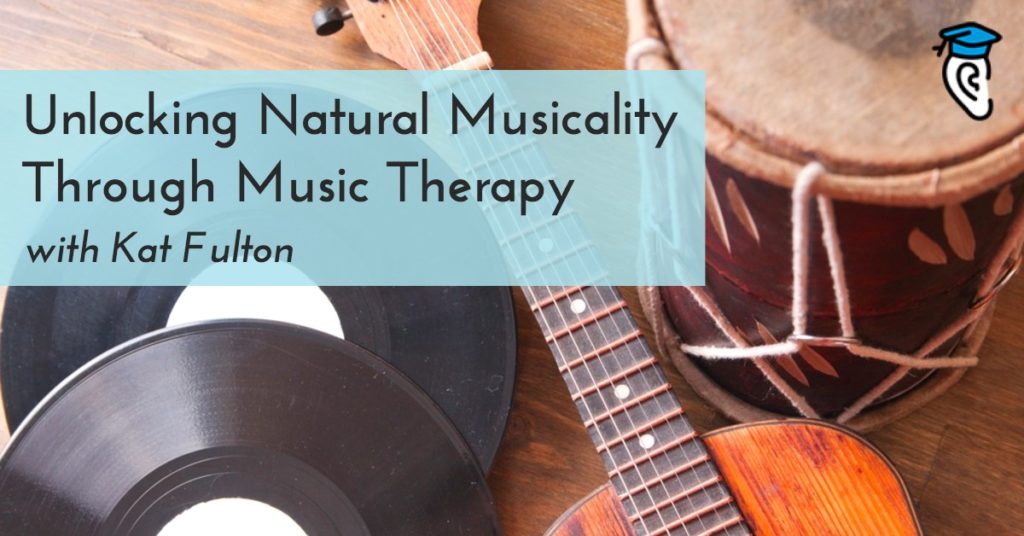Music is at the heart of our humanity. Whatever musicality you think you do or don’t possess, a steady driving rhythm or the moving melody of a favourite song have a power to move us, both literally and emotionally. But how do you tap into that musical power—particularly if you consider yourself “unmusical”? That’s the special skill of music therapists who use music and musical activities to help heal, teach and nurture people from every background and in a wide variety of circumstances.
 Kat Fulton is one of the leading figures in music therapy today, pioneering online continuing education for music therapists at Music Therapy Ed, a website that has now helped more than 3,000 music therapists to develop and extend their skills. She is a charismatic and inspiring speaker and coach, and has facilitated drum circles with the US Surgeon General and teams at Fortune 500 companies. Her motto is “Be Well, Feel Good, and Make Music”.
Kat Fulton is one of the leading figures in music therapy today, pioneering online continuing education for music therapists at Music Therapy Ed, a website that has now helped more than 3,000 music therapists to develop and extend their skills. She is a charismatic and inspiring speaker and coach, and has facilitated drum circles with the US Surgeon General and teams at Fortune 500 companies. Her motto is “Be Well, Feel Good, and Make Music”.
We invited Kat to share some of her experience and insights on the world of music therapy, including: who becomes a music therapist, what kinds of situation can music therapy be useful in, and why is it that music has a power for therapy in the first place?
Q: Could you tell us about the kinds of situation where music therapy is a helpful treatment?
Is it only for “patients”, or is this a type of therapy which can benefit even people who consider themselves “healthy”?
 Awesome question! Music therapists work in four general settings:
Awesome question! Music therapists work in four general settings:
- medical,
- psychiatric,
- educational, and
- wellness.
We call the people we serve “patients,” “clients,” or “students” depending on the setting.
A great example of someone healthy benefiting from our work would be healthcare staff, educational administrative staff, or corporate clients. In the corporate wellness setting, music therapists are hired to create team building through rhythm experiences! Imagine: Everyone from the janitor to the CEO with a world percussion instrument in their hands… Enticing right? ;) Spirit tunnels and gong strikes, all the way! Kinda like this:
Absolutely! Betty was a patient in a medical hospital. She was admitted three days prior to the music therapy referral, and when I received the referral she was documented as “non-verbal” and combative.
The staff told me “You should stand in the doorway because she might start hitting you.” In her chart, I noticed that she was 88 years old, from the midwest.
I stood in the doorway, looked her in the eye, and sang Daisy, Daisy, Give me your answer do…
As the first verse came to a close, she belted out:
“You’ll look sweet! Upon the seat! Of a bicycle built for TWOOOOOO!”
She started singing again from the top. Meanwhile, staff gathered around me, jaws dropped, in awe of this talking patient, who hadn’t said a word in three days. Needless to say, after she sang, that was a great time for the staff to administer medication and give her the bath that she had been resisting for days.
This is an example of how music therapy can reduce agitation and combativeness. It can make healthcare professionals’ jobs easier. It can save time in administrating medication. And it can save money. I have a million more stories that we’ll have to do a second interview on!
I feel like this is a passion you share. Could you tell us a bit about your work in that area, of nurturing and unlocking people’s natural musicality?
Absolutely. In music therapy, musical experience is unnecessary to achieve goals and see results.
“As humans, we are biologically wired for rhythm.
We walk in rhythm.
We breathe in rhythm.
We have heartbeats set to rhythm.
We are rhythm.”
I always tell my clients that as humans, we are biologically wired for rhythm. We walk in rhythm. We breathe in rhythm. We have heartbeats set to rhythm. We are rhythm. That’s why entrainment comes so naturally. That’s usually how I start, and then from there I set up opportunities for the client to shine through improvisation, scat singing, or even walking if that’s a goal.
It’s difficult to describe the process unless I refer to a specific population. Imagine a stroke patient working on gait. In rehabilitation, music therapy can be used to accelerate the process. For example, this stroke patient may have a baseline walking pace and a goal walking pace. We use the patient’s culturally-specific, preferred music in a rhythmic way to reinforce his or her walking pace. Studies have shown that music therapy can accelerate the rehabilitation process.
And of course, this therapeutic process looks different in rehab versus NICU, pediatrics, at-risk teens, cancer patients, Alzheimer’s/dementia…
Sure! Like I mentioned before, biologically programmed for rhythm. Heartbeat, walking, jumping, dancing, even language has prosody and rhythm.
It’s fascinating that in our society today, we are trained to attend concerts and sit down with our hands folded in our laps. What’s more natural is to move to the music and play with the music and entrain!
“You sit at a piano with 88 keys, and 87 of them are the “wrong note.”
You play a drum, and there’s no wrong way to play.”
Many people today talk about the torturous piano lessons they had growing up, or the choir director asking them to lip-sync in the back for the concert. Many of us have negative associations with making music.
Because there are no wrong notes on the drums, they are a great introduction to making music. You sit at a piano with 88 keys, and 87 of them are the “wrong note.” You play a drum, and there’s no wrong way to play.
“What if my clients can’t pick up the rhythm?”
a video from Music Therapy Ed with expert Christine Stevens
I wish people knew that music can have negative effects. That’s why it’s important to find a certified music therapist in your area if you’re seeking help for a loved one.
Here’s an example from my friend Lillieth Grand: a teenage kid was in a coma, and the family had heard that Mozart makes people smarter and classical music increases intelligence. So the family thought this would be the best fit for their son. They brought in classical music and his vitals became irregular and stressed. When the music therapists performed an assessment, she found out that his preferred music was death metal. Although the parents apologized for his preference, the music therapist suggested that death metal would be the best fit. They introduced death metal, and his vitals became regular again.
The studies that “legitimized” the Baby Mozart wave in the 1990s have been replicated and refuted numerous times over and over and even classical music can actually be harmful.
This is a tough question. Most music therapists start with a high school diploma. At that point, whether they are more musician or more therapist is debatable.
Becoming a certified music therapist requires a bachelors degree in music therapy at minimum. Within the music therapy standardized curriculum, the soon-to-be music therapist takes courses in behavioral sciences, psychology, and counseling in addition to courses in music. All music therapists are proficient in guitar, piano, and voice.
I would recommend finding a practicing music therapist in your area and observing them work!
But not just in one setting… Request observations from music therapists who work in schools, mental health, medical, and wellness settings. If I had only seen music therapists work in schools before signing up then I would not have been sold. Capiche?
Q: Music Therapy Ed seem to always have a wonderful variety of projects and workshops underway. Could you give us an idea of what you have in store for the future that has you particularly excited?
 Come join us for our next Mindstorm Monthly webinar! These are free webinars where we cover a variety of topics, including music and birthing, pain management, autism, drum circle facilitation, and so much more.
Come join us for our next Mindstorm Monthly webinar! These are free webinars where we cover a variety of topics, including music and birthing, pain management, autism, drum circle facilitation, and so much more.
Feeling inspired to learn more about your inner rhythm or the field of music therapy? Great! Go ahead and get to know Kat Fulton through her website, KatFulton.com, as well as on Twitter and Facebook, and explore the world of Music Therapy Ed, including the free Mindstorm Monthly webinars at MusicTherapyEd.com.







